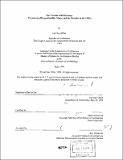| dc.contributor.advisor | Mark Jarzombek. | en_US |
| dc.contributor.author | Miller, Carl Ray, 1962- | en_US |
| dc.contributor.other | Massachusetts Institute of Technology. Dept. of Architecture. | en_US |
| dc.date.accessioned | 2012-01-30T16:48:35Z | |
| dc.date.available | 2012-01-30T16:48:35Z | |
| dc.date.copyright | 1999 | en_US |
| dc.date.issued | 1999 | en_US |
| dc.identifier.uri | http://hdl.handle.net/1721.1/68793 | |
| dc.description | Thesis (S.M.)--Massachusetts Institute of Technology, Dept. of Architecture, 1999. | en_US |
| dc.description | Includes bibliographical references (leaves 62-63). | en_US |
| dc.description.abstract | Throughout the late 1940's and early 1950's the re-popularization of the relationship between architecture and music took on several forms of expression. This relationship was to be verified through the notion of harmony that would in turn reflect not only a resurfacing of Humanist ideals and values as a cultural post-war response, but would also provoke a series of debates on proportion and proportion studies that would question these cultural demands against these systems based on preconceived notions of natural law. This study explores the particular contexts in which the idea of harmony was discussed and practiced through the 1950's relative to architecture and music as a reflection of natural law that, by the early 20th century, had been undermined by the practices of music. The analysis examines two particular case studies, the publication of Rudolph Wittkower's Architectural Principles in the Age of Humanism, published in 1949, and the Phillips Pavilion, commissioned by Phillips Electronic Corporation, and designed by the office of Le Corbusier that was constructed at the World's Fair in Brussels in 1958. | en_US |
| dc.description.statementofresponsibility | by Carl Ray Miller. | en_US |
| dc.format.extent | 63 leaves | en_US |
| dc.language.iso | eng | en_US |
| dc.publisher | Massachusetts Institute of Technology | en_US |
| dc.rights | M.I.T. theses are protected by
copyright. They may be viewed from this source for any purpose, but
reproduction or distribution in any format is prohibited without written
permission. See provided URL for inquiries about permission. | en_US |
| dc.rights.uri | http://dspace.mit.edu/handle/1721.1/7582 | en_US |
| dc.subject | Architecture. | en_US |
| dc.title | The problem with harmony : constructs of proportionality, music and the Modulor in the 1950's | en_US |
| dc.type | Thesis | en_US |
| dc.description.degree | S.M. | en_US |
| dc.contributor.department | Massachusetts Institute of Technology. Department of Architecture | |
| dc.identifier.oclc | 43642209 | en_US |
